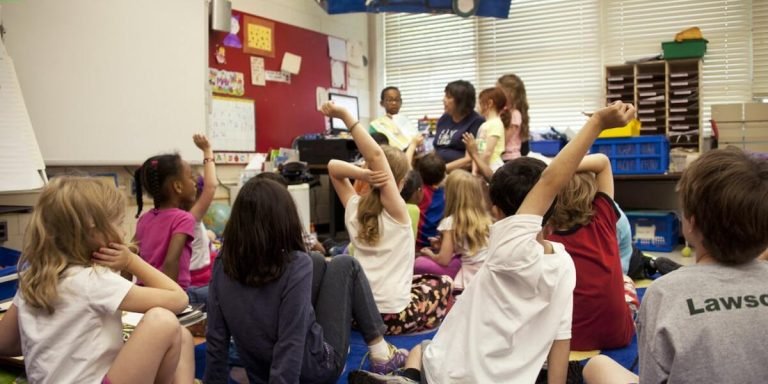What Do 6th Graders Learn in Math? A Detailed Look at the Curriculum
Are you curious about “what do 6th graders learn in math?” Middle school education, particularly sixth-grade math, balances a fine line between primary arithmetic and the intricate world of algebra and geometry. This transition period is crucial as it builds upon the mathematical foundation laid during elementary years while setting up students for more advanced concepts they will encounter later.
In this post, we’ll embark on an explorative journey into the typical mathematic curriculum of most sixth-grade classrooms across various educational frameworks. From fractions to ratios or basic geometric principles, get ready to delve deep into what your child learns at this vital stage – thereby equipping yourself with knowledge that can help support their learning progress effectively.
Did you know?
Did you know that the concept of ratio and proportion, which is a key part of 6th grade math curriculum, has been in use since as early as 1800 BC by ancient civilizations for setting fair prices and wages?
Understanding the Core Mathematics Curriculum for 6th Graders
Mathematics in the 6th grade is a whirlpool of diverse concepts and activities, offering young minds abundant avenues to bloom. The core curriculum introduces students not only to advanced arithmetic but also raises the curtain on exciting facets such as geometry, algebraic expressions and equations. It provides an essential starting point for their immersions into more abstract mathematical theories later.
The leap from shapes made up simply squares or triangles in previous grades explodes into exploring two-dimensional figures via area, surface area, volume calculations – essentially applying real-world meaning behind those funny-looking squiggles they drew so enthusiastically just few years ago! Here’s where technology really starts integrating with math education. Computer-based tools provide interactive models enabling kids grasp spatial relationships & get hands-on experience manipulating geometrical structures.
They start dabbling with expressions at first – learning basic principles around distributive property that allow them properly expand brackets (e.g.,3(2+4) = ?), subsequently delving headfirst solving simple single-variable equations leading onto developing reasoning skills through patterns/relationships analyses between both sides equation.
Key Components of Sixth-Grade Math Education
Incorporating technology into education has been a game-changer, and sixth-grade mathematics is no exception. Parents often wonder – “what do 6th graders learn in math”, especially with the evolving methods of teaching through digital tools.
Technology integration simplifies and deepens the understanding of mathematical concepts at this developmental stage. Here are some key components that 6th graders learn in their math lessons in today’s digitally dominated age:
1. Number Sense: This segment involves an understanding of numbers, which includes operations like addition, subtraction, multiplication and division – both on paper and using tech-based tools such as virtual manipulatives or maths apps.
2. Algebraic Concepts: Sixth-graders begin to explore basic algebraic expressions where they use variables to represent quantities—this can be made practical by programming equations into software that visually demonstrates outcomes when values change.
4.Number Theory/Statistics/Probability: Students delve into number systems other than decimals- fractions & integers come under scrutiny here too along with statistical data analysis—the latter turns engaging through graphs plotted using computer programs.
Navigating Through Numbers: Arithmetic at the Middle School Level
In sixth grade, children delve deeper into foundational mathematical domains such as fractions, decimals, geometry and measurements while simultaneously being exposed to new subjects like pre-algebra and statistics. There is an increased focus on computational fluency – quick recall of facts and flexible mental computation skills.
The first key area that six graders explore is ratios – comparing two quantities by division or multiplication. Students are taught how proportions can describe relationships between different data sets which they encounter in real-world applications regularly.
Next comes the study of whole numbers – operating with multi-digit numbers using four basic operations: addition, subtraction, multiplication & division but now doing so more complexly than before.
Decimals also play a pivotal role; students get familiarized with adding them together or subtracting from one another smoothly without much hand-holding anymore.
Moving forward through this transitionary year’s curriculum sees introduction of variables leading towards budding algebraic thinking followed by rudimentary statistical analysis wherein pupils engage themselves in organizing data visually via graphs etcetera .
The Role of Geometry in a 6th Grader’s Mathematical Journey
As we delve into the insights of what a 6th grader learns in math, it becomes evident that geometry plays an instrumental role. The geometrical journey starts with understanding shapes and lines and gradually moves on to more complex concepts like calculating area, surface area, volume and recognizing different types of angles. These foundational lessons not only define their mathematical competence but also serve as stepping stones for advanced studies.
In this digital age of 2023, technology integration has been significantly revolutionizing education methodologies. It’s quite common now to see educators weave technology tools into mathematics instruction at the middle school level especially in teaching geometry concepts better than ever before. Interactive geometric software programs help students visualize three-dimensional figures or explore properties of a rotating shape – experiences that are impossible through mere chalk-talk.
It’s fascinating how effectively these tech-enabled practices have made intricate topics such as geometric representation seem tangible and easier for our sixth graders! Let alone fostering active engagement among pupils; they simplify abstractions thus promoting problem-solving skills which is crucial in any subject particularly so in mastering Math during Middle School Education.
Shapes, Spaces, and Measurements: A Geometric Foundation
In a typical sixth-grade math curriculum, geometry plays an essential role. By the time students reach this grade level, they’re not just learning fundamental arithmetic; they’re venturing into more advanced mathematical concepts that involve recognition and manipulation of shapes, spaces and measurements.
The exploration of these geometric elements provides children with a firm foundation for their future studies in mathematics. It paves the way to understand abstract theories when applied to real-life problems or scenarios such as architecture design or physics calculations.
This year 2023 has witnessed remarkable leaps in technology integration within education. These advancements have made it possible for our young learners to better visualize and interact with complex geometrical forms through digital tools both at home and inside classrooms.
With cutting-edge software applications powering interactive lessons on tablets or school computers, 6th graders are exposed early on to what was once exclusive mostly for higher levels –- immersive learning environments where solid three-dimensional figures can be manipulated conveniently anytime at any pace preferred by the user.
Exploring Angles and Their Applications in Daily Life
In the ever-evolving landscape of education, technology integration has become a pivotal component especially when it comes to teaching Mathematics. This transformation is evident in 6th grade math curriculum where students embark on their journey of understanding geometry’s role.
A critical aspect that sixth graders learn in mathematics is exploring angles and their applications in daily life. Comprehending angles goes beyond just learning what they are –– right, obtuse or acute; it includes interpreting how these form elements of our day-to-day lives and surroundings.
As kids begin to relate classroom concepts with real-world experiences, abstract notions start transforming into tangible instances. For instance, consider any simple item like a book placed against the wall on your table top: The point at which this book meets the wall – that’s an angle! Once children identify such connections between geometry and everyday reality, understanding becomes more profound, engaging as well as enjoyable!
Developing Critical Thinking with Statistics and Probability in Grade Six
In the world of 6th-grade mathematics, students dive deeper into more complex areas of study. One notable segment is statistics and probability which forms an integral part of their mathematical journey. This subject not only develops numerical competency but also enhances the critical thinking abilities in young minds.
With an increased focus on technology integration in education, youngsters are now learning these difficult concepts through interactive educational software applications and virtual manipulatives instead of traditional textbooks alone. Tech tools provide real-world scenarios making abstract ideas easily understandable for sixth graders.
Moreover, online math games dealing with statistical data analysis or probabilities take a hands-on approach to engage learners effectively while enabling them to visualize patterns better using colorful graphics that simplify otherwise complex problems. These tech-aided activities foster curiosity among children about numbers’ behavior and relationships leading to improved problem-solving skills proving beneficial beyond just middle school education.
Unveiling Data Analysis: How Middle Schoolers Interpret Information
In the technologically advanced world of 2023, understanding data and information is vital. Hence, it’s crucial to introduce middle school students, particularly sixth graders, to statistics and probability at an early age.
When asked “what do 6th graders learn in math?”, one key area they dive into is Data Analysis – a foundational skill that empowers them with the ability for critical thinking. Through this aspect of mathematics curriculum tailored specifically for middle school education, children develop their abilities to interpret statistical information accurately which plays a pivotal role in decision making throughout life.
Educators or parents seeking to effectively develop these skills in youngsters while integrating technology into the education system can incorporate several strategies:
1) Usage of Digital Tools: There are numerous online tools available nowadays that help teach statistics and probability concepts. These platforms display real-time data analysis results enabling pupils comprehend theories effortlessly.
2) Interactive Games: Online games involving prediction outcomes based on probabilities foster interest towards this subject whilst enhancing cognitive learning levels.
3) Simulations & Animations: Visually appealing content simulates situations where kids can observe how probabilities alter eventualities helping understand variabilities better.
4) Real-life Projects: Involving children in projects such as weather predictions using historical climate patterns encourages perspective around practical implication of learned subjects beyond textbooks.
Probability Principles: Introducing Outcomes and Events to Preteens
As parents and educators, it’s vital to understand what 6th graders learn in math. This stage of a child’s learning development is pivotal for their intellectual growth. One fundamental topic they delve into includes the principles of probability.
In an effort to maintain steady engagement while fostering critical thinking, probability isn’t just thrown at them as raw numbers on paper; instead, it’s introduced with real-life scenarios or events that mirror everyday occurrences. This tangible approach creates meaningful context by demonstrating these mathematical concepts within situations familiar to preteens.
For instance, flipping coins generates interest due to its simplicity yet provides immense depth when explaining outcomes and events tied with probabilities – any coin toss has two possible outcomes: heads or tails. Introducing this game during lessons will help students visualize how theoretical aspects work in practice whilst nourishing their analytical skills simultaneously.
Understanding the concept of “outcomes” becomes even more intriguing once cards are involved – there can be several possibilities ranging from different combinations pertaining to suites down to specific card numbers which span over numerous cases shaping a foundation for statistical theory exploration later on.
Moreover, games like dice throws further emphasize multiple outcome analysis given one throw houses six potential results thereby allowing kids ample room for prediction conception strengthening thus underlining another integral aspect essential during ‘probability’ discussions.
Conclusion
In conclusion, the depth of “what do 6th graders learn in math” is surprisingly intricate and integral to your child’s overall academic growth. With subjects varying from algebraic equations to geometric understanding, it all contributes towards establishing a strong foundation for future complex mathematical theories.
We hope this article has shed some light on what you can expect during this critical educational year. If you’re left thirsting for more information about childhood education or how best to support their journey as parents or educators, we invite you not hesitate in scrolling through our website. We have an abundance of resources that promise guidance at every turn of your young scholar’s learning path!







